As General Motors Go, So Goes the Nation
By James Quinn,
a certified public accountant
and a certified cash manager
TheBurningPlatform.com
Advertisements:
 General
Motors (GM) was
founded in 1908 in Flint, Michigan, and grew to be the largest corporation
in the world. Its market capitalization reached $50 billion in 2000.
In the past week, its market capitalization dropped below $1 billion
to levels last seen during the 1920s. The story of General Motors
is the story of America. In 1953, at the peak of its dominance,
its President, Charles Wilson, declared before Congress that what
was good for the country was good for GM and vice versa. Its rise
to power and decline towards insolvency parallel the rise and fall
of the Great American Republic. Overconfidence, hubris, lack of
courage, foolish decisions made, and crucial decisions deferred
have been the hallmarks of GM and U.S. GM’s stock price reached
$1.77 last week, a 71 year low. It peaked at $100 during the Dot
Com boom in 2000 and was still at $50 in 2007. The market has voted
and it says GM is bankrupt. General
Motors (GM) was
founded in 1908 in Flint, Michigan, and grew to be the largest corporation
in the world. Its market capitalization reached $50 billion in 2000.
In the past week, its market capitalization dropped below $1 billion
to levels last seen during the 1920s. The story of General Motors
is the story of America. In 1953, at the peak of its dominance,
its President, Charles Wilson, declared before Congress that what
was good for the country was good for GM and vice versa. Its rise
to power and decline towards insolvency parallel the rise and fall
of the Great American Republic. Overconfidence, hubris, lack of
courage, foolish decisions made, and crucial decisions deferred
have been the hallmarks of GM and U.S. GM’s stock price reached
$1.77 last week, a 71 year low. It peaked at $100 during the Dot
Com boom in 2000 and was still at $50 in 2007. The market has voted
and it says GM is bankrupt.
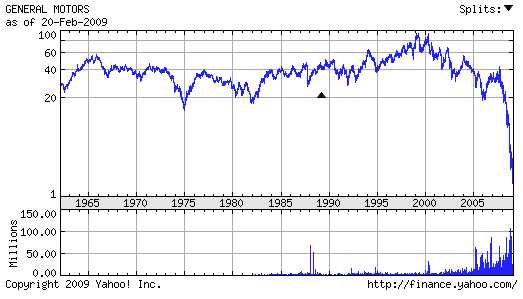
American carmakers have seen their market share drop from 85%
in 1985 to 43% today. GM’s market share peaked at almost 50% in
the 1960’s. It reached a historic low of 19.5% in January. Its sales
plummeted 49% from a year ago. GM has too much debt, too much bureaucracy,
too many plants, too many car lines, too many employees, and too
many future healthcare and pension obligations. Of course, the only
way a company can be in such a disastrous position is through decades
of mismanagement. The only logical solution is for GM to enter a
pre-packaged bankruptcy with financing provided by the U.S. government
if bank financing is unavailable. Shareholders and bondholders will
be wiped out. They made a bad investment. Plants will be closed,
UAW contracts restructured, management replaced, employees fired,
debt written off and future obligations reduced. A much smaller
viable company that can compete in the 21st Century would exit bankruptcy
in a year or two. A profitable, low market share is preferable to
a high market share with billions in losses.
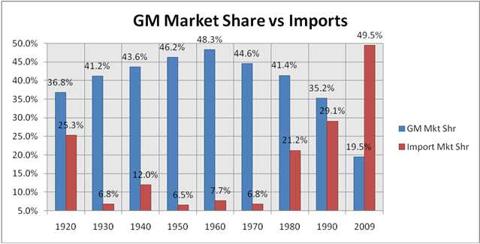
Source: Automotive Data Center & R.L. Polk
The decline of GM is a testament to how poor strategic decisions
over the course of decades will ultimately lead to collapse. The
United States has followed the GM model of failure for the last
three decades. The U.S. has too much debt, too much bureaucracy,
too many government supported industries, too many agencies, too
many employees, and $53 trillion of unfunded future liabilities.
See any similarities to GM? Can the U.S. avoid the fate of GM, or
is it too late? If we can learn the important lessons of the GM
decline, it may not be too late to reverse our course. Or we can
continue on the current path and follow the advice of Will Rogers.
If stupidity got us into this mess, then why can’t it get
us out?
Meteoric Rise
By the early 1920s, General Motors had surpassed Ford Motor Company
(F) as the largest car company in the U.S. under the leadership
of Alfred P. Sloan. He created the concept of annual styling changes
that kept consumers coming back. He also established a pricing structure
for each of GM’s brands from lowest to highest (Chevrolet, Pontiac,
Oldsmobile, Buick and Cadillac). The idea was to keep a family coming
back to GM over time as they became wealthier. He was a pioneer
who drove GM to become the largest and most profitable industrial
enterprise the world had ever known. His words reflect that spirit.
There has to be this pioneer, the individual who has the
courage, the ambition to overcome the obstacles that always develop
when one tries to do something worthwhile, especially when it
is new and different.
In the midst of the Great Depression, Mr. Sloan was able to keep
General Motors profitable. That is an indication of a smart, realistic
businessman who didn’t make poor decisions during the Roaring 20s.
GM’s results during the heart of the Depression, when one-third
of all dealers went broke, according to Automotive Daily News were:
- 1929 Net sales - $1,504,404,472 Net income - $248,282,268
- 1930 Net sales - $983,375,137 Net income - $151,098,992
- 1931 Net sales - $808,840,723 Net income - $96,877,107
- 1932 Net sales - $432,311,868 Net income - $164,979
By 1936, GM managed to increase car sales to 1.7 million and to
2 million by 1941, before converting operations to military requirements.
Only an executive like Sloan comfortable in his own skin and tolerant
of other opinions would speak the following words.
If we are all in agreement on the decision - then I propose
we postpone further discussion of this matter until our next meeting
to give ourselves time to develop disagreement and perhaps gain
some understanding of what the decision is all about.
The best business decisions are made after open debate that includes
dissenting opinions and arguments. Only great leaders allow this
type of decision making. Alfred Sloan led GM for over 30 years,
retiring in 1956. GM’s profit in 1955 had reached $1.2 billion ($8
billion in today’s dollars). It was on top of the world.
On Top of the World
During World War II General Motors produced armaments, tanks, vehicles,
and aircraft to help the Allies to victory. During the 1950s, GM
became the largest corporation in America and became the 1st company
to pay taxes over $1 billion in a single year. In 1955, GM employed
624,000 Americans. In the copy of the 1955 GM Annual report below,
it shows that only 27 cents of every dollar of revenue was paid
to employees. The GM business model was very profitable. Their market
share peaked at 54% in 1954, the same year they sold their 50 millionth
automobile. After the retirement of Sloan, a visionary leader failed
to materialize. GM began to show signs of overconfidence as the
1960s arrived. They started to believe their own press clippings.
They failed to heed the advice of another well known auto man Lee
Iacocca.
The most successful businessman is the man who holds onto
the old just as long as it is good, and grabs the new just as
soon as it is better.
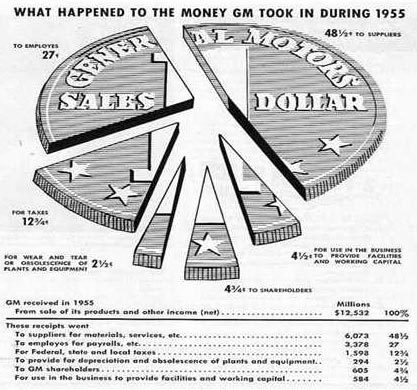
Peter Drucker, the world renowned management guru, wrote a detailed
analysis of General Motors in 1946 called Concept of the
Corporation. His suggestions to management and the UAW
were scoffed at by both parties. He suggested the automaker might
want to reexamine a host of long-standing policies on customer relations,
dealer relations, and employee relations. Among his specific recommendations
was for GM's hourly workers to assume more direct responsibility
for what they did, adopting a "managerial aptitude" and
operating within a "self-governing plant community." The
UAW's powerful president, Walter Reuther, greeted that notion this
way: "Managers manage and workers work, and to demand of workers
that they take responsibility for what is management's job imposes
an intolerable burden on the working man." Reuther did not
fall into the “visionary” category.
Glory Days
As the 1960s began, GM began decades of reacting to competitors
rather than showing the way. As the European car makers introduced
smaller cars, GM introduced the Chevrolet Corvair. This car later
was attacked by Ralph Nader, who wrote the book Unsafe at Any Speed,
which led to congressional auto safety hearings. Speed took precedence
over safety. GM continued to maintain its worldwide dominance through
the 1960s into the 1980s. New car controversy plagued the company
during these decades. Every decade, a major new product line was
launched with defects of one type or another showing up early in
their life cycle. In every case improvements were eventually made
to fix the problems, but the resulting improved product ended up
failing in the marketplace as its negative reputation overshadowed
its eventual quality. Again, Lee Iacocca’s wisdom went unheeded
at GM.
In the end, all business operations can be reduced to three
words: people, product, and profits.
Renaissance Center – GM Headquarters
(Image source: Wikipedia)
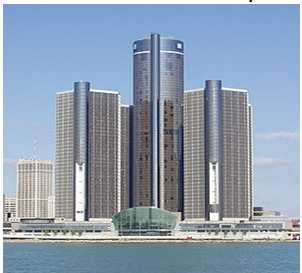 GM
forgot that superior products developed by superior people lead
to profits. The 1970s were marked by more disastrous product launches.
Who could forget the Vega? Quality was not job one for GM. The last
major strike by the UAW also occurred in 1970. After that, management
continually gave in to the union demands in all future contract
negotiations. They promised tremendous pension benefits, lifetime
healthcare benefits, huge pay increases, and onerous work rules
that gave management no flexibility. GM evidently didn’t have any
bean counters who could extrapolate past a five year horizon. If
they had, they would have seen that they would eventually have an
unsustainable cost structure with more retirees being paid than
workers on the assembly line. The troubling facts were ignored because
GM still had a 45% market share during the 1970s. GM's U.S. employment
reached 618,365 in 1979, making it the largest private employer
in the country. Worldwide employment broached 853,000. It has been
downhill ever since. GM
forgot that superior products developed by superior people lead
to profits. The 1970s were marked by more disastrous product launches.
Who could forget the Vega? Quality was not job one for GM. The last
major strike by the UAW also occurred in 1970. After that, management
continually gave in to the union demands in all future contract
negotiations. They promised tremendous pension benefits, lifetime
healthcare benefits, huge pay increases, and onerous work rules
that gave management no flexibility. GM evidently didn’t have any
bean counters who could extrapolate past a five year horizon. If
they had, they would have seen that they would eventually have an
unsustainable cost structure with more retirees being paid than
workers on the assembly line. The troubling facts were ignored because
GM still had a 45% market share during the 1970s. GM's U.S. employment
reached 618,365 in 1979, making it the largest private employer
in the country. Worldwide employment broached 853,000. It has been
downhill ever since.
In 1983, in an epilogue to 1946’s Concept of the Corporation, Peter
Drucker wrote: "GM may, within a decade, develop into a true
transnational company that integrates markets of the developed world
and their purchasing power with the labor resources of the Third
World." And "while it is much too early even to guess
what GM's labor relations will look like," he added, "the
assembly line, that symbol of industry during the first half of
the century, will, by the year 1990 or the year 2000, probably have
faded into history." Mr. Drucker underestimated the lack of
vision and foresight of GM management. They continued to follow
the old ways until it was too late. Japanese carmakers arrived like
a freight train during the 1980s and have never let up. GM has essentially
been in a death spiral for the last 30 years. Throughout the 1980s,
GM rolled out more duds like the Chevrolet Citation, Chevrolet Cavalier,
and Pontiac Sunfire.
Bruce Springsteen touched on the future of the U.S. auto industry
in his classic "Glory Days."
My old man worked 20 years on the line
And they let him go
Now everywhere he goes out looking for work
They just tell him that he's too old
I was nine years old and he was working at the
Metuchen Ford plant assembly line
Now he just sits on a stool down at the legion hall
But I can tell what's on his mind
Glory days yeah goin back
Glory days aw he ain't never had
Glory days, glory days
Decline of an Empire
Roger Smith ran GM from 1981 until 1990. During his reign, GM’s
market share dropped from 46% to 35%. His biggest claim to fame
is being the subject of Michael Moore’s first documentary Roger
& Me, which was extremely critical of his laying off of thousands
of employees in Flint, Michigan. He took over GM in 1981 while it
was losing $750 million, its 1st loss in 60 years. Poor product
quality, labor unrest and lawsuits over unsafe vehicle designs affected
sales volumes in the early 1980s, which led to GM losing market
share at an alarming rate to foreign automakers. In 1981, U.S. Union
autoworkers responded to the Japanese threat by bashing Japanese
automobiles with sledgehammers. I’m sure this made them feel better,
but it was a futile and useless gesture. Smith attempted to institute
Japanese manufacturing techniques, but the ingrained bureaucracy
resisted change and foiled his efforts. A culture of mediocrity
and poor quality led to continuous decline rather than continuous
improvement. The acquisition of EDS from Ross Perot in 1984 was
a failure. Perot attempted to change the culture of GM, but failed.
Perot liked to say that getting GM moving again was like teaching
an elephant to dance.
General Motors had a chance to take a commanding lead in the mid
1990s. It developed the 1st electric car, the EV1 in 1996. Instead
of taking advantage of this opportunity to change the automotive
world, GM scrapped this car and destroyed all of the models. It
decided the future was in trucks, SUVs, and Hummers. It continued
to roll over to the unions every time a contract came up for renegotiation.
This ultimately led to an average hourly labor cost of $73.26 for
GM by 2006, a 65% premium to what the Japanese pay their autoworkers.
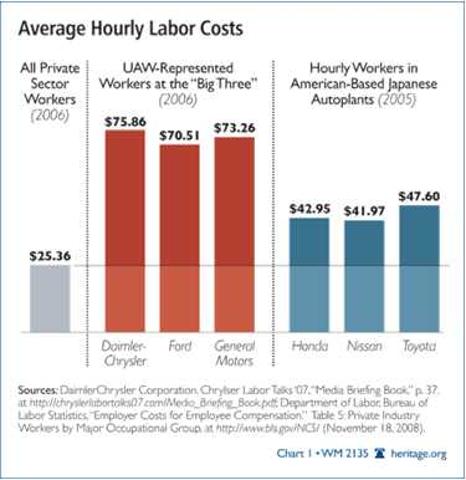
GM sold its soul to the devil of debt and high margin, low mileage
vehicles. SUVs generated a profit of $10,000 to $15,000 per vehicle,
even with GM’s bloated cost structure. Rather than improve its assembly
line efficiency, product design & quality, or solidify its balance
sheet, it chose to use its GMAC subsidiary to make loans to subprime
borrowers at 120% of the car’s value. After 9/11, GM showed its
dedication to the flag by giving cars away with 0% financing. Amazingly,
when you provide 0% financing to people with 550 credit scores you
can sell millions of Escalades and Hummers. While Rome was burning
GM management continued to fiddle. There hundreds of Presidents,
Vice-Presidents, and Directors continued to fly around in their
fleet of 7 corporate jets. As Rick Wagoner and his top cronies secluded
themselves in executive suites on the 14th floor of their palatial
headquarters, eating steak and lobster in their executive dining
room, served by minions, GM was rotting from within.
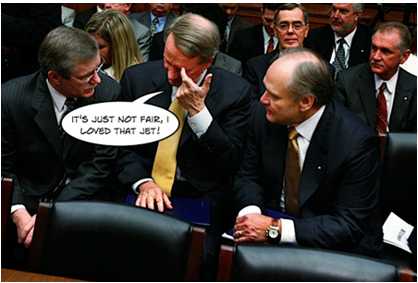
Source: Autoblog.com
Giving away cars for free was so successful, GM decided to parlay
its expertise into giving homes away for free. It bought Ditech
in 1999, just in time to catch the greatest housing bubble of all
time. Ditech was a pioneer in offering 125 percent loans, in which
the borrower could get more than the property was worth. It specialized
in no-documentation mortgages and stated income loans. How could
lending someone 125% of a home’s value with no proof of income or
assets possibly go wrong? To quote Claude Rains from Casablanca,
“I'm shocked, shocked to find that gambling is going on in here!”
GMAC surprisingly lost $8 billion in the last two years. Luckily,
the American taxpayer has stepped in to provide GMAC with $5 billion
of TARP so it can continue to allow GM to sell more cars at a $2,000
loss per car. No need to worry, it's hired some Wall Street wizards
from Citicorp who have figured out that they can make it up on volume.
Paul Kedrosky recently provided a fascinating look at how two decades
of profits could be wiped out in seven months. With 260,000 remaining
employees, the end is near for this fallen giant.
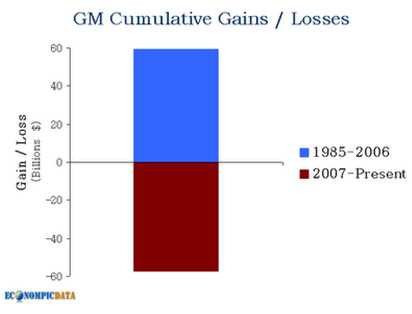
Source: Paul Kedrosky Infectious Greed
A corporate governance study at ragm.com sums up the reasons for
GM’s decline.
The history of GM is an instructive story in how success
can breed failure; how being the biggest and the best can lead
to arrogance and an inability to adapt. GM was the premier car
company in the world for so long that it failed to see the need
for change. The company was so used to being leader that it couldn’t
contemplate following others. It was this mindset, this overwhelming
belief that it was GM’s divine right to be the most successful
automobile company on earth that condemned the company to two
decades of disaster. When GM did finally see the need to adapt,
it did so with wild ineptitude, spending tens of billions in the
1980s for little reward.
General Motors has lost $72.5 billion in the last three
years. Why is the American taxpayer propping up this failed entity?
Long Road to Ruin
Bill Gross, one of the wisest and deepest thinkers in the financial
world, wrote a report in May 2006 that compared the plight of GM
with the plight of the United States. Mr. Gross’s words of almost
three years ago ring even truer today.
I think it is important to recognize that General Motors
is a canary in this country’s economic coal mine; a forerunner
for what’s to come for the broader economy. Their mistakes have
resembled this nation’s mistakes; their problems will be our future
problems. If the U.S. and General Motors have similar flaws and
indeed symbiotic fates, they appear to be conjoined primarily
by the un-competitiveness of their existing labor cost structures
and the onerous burden of their future healthcare and pension
liabilities. Perhaps the most significant comparison between GM
and the U.S. economy lies in the recognition of enormous unfunded
liabilities in healthcare and pensions. Reportedly $1,500 of every
GM car sold in dealer showrooms goes to pay for current and future
health benefits of existing and retired workers, a sum totaling
nearly $60 billion. The total future healthcare liability for
all U.S. citizens can be measured in the tens of trillions.
General Motors failed to find a solution to its problems. CFO Fritz
Henderson admitted in 2006 that, “I have a social security system
hooked to our balance sheet.” The reason he had a social security
system hooked to his balance sheet was because previous management
had made commitments that could never be kept in the long run in
order to keep the party going in the short run. Sounds like GM management
would do extremely well in government jobs.
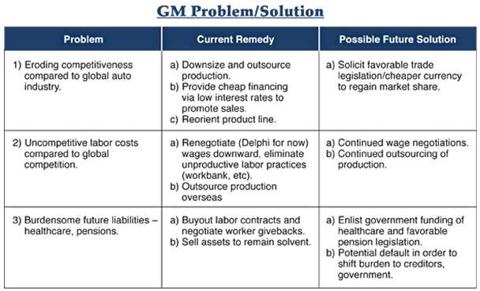
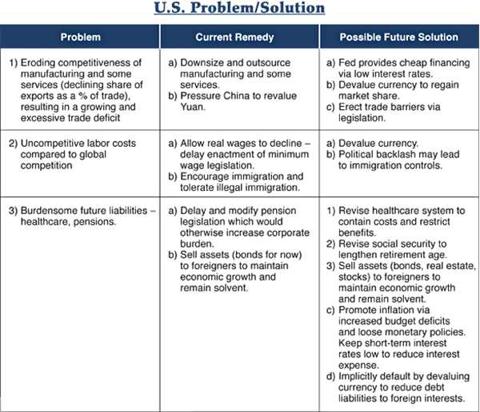
Source: PIMCO
Eroding Competitiveness
The United States peaked as a manufacturing economy in 1960, with
manufacturing employees making up 26% of the workforce. They now
make up less than 10% of the workforce. Total manufacturing jobs
peaked at 19 million in the late 1970s and now have plummeted below
14 million and continue to fall. The U.S. decided to outsource manufacturing
jobs because we were going to do the thinking for the world. Why
get your hands dirty creating things when our brilliant MBA trained
geniuses could turn loans to deadbeats and frauds into AAA rated
Mortgage Backed securities? The U.S. decided to take the easy path
of financial engineering rather than the hard path of creating products
that other countries would buy.
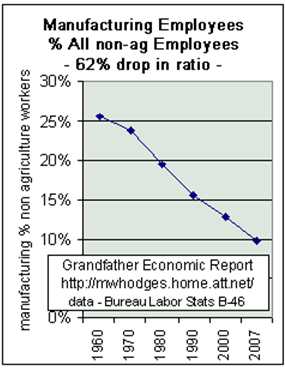
The trade deficit caused by decades of choices by government and
industry reached $677 billion in 2008. These deficits were always
unsustainable. Borrowing from the Chinese and Japanese to buy stuff
produced by China and Japan could never go on forever. Instead of
realizing this imbalance and taking actions to gradually rebalance
the world financial system, our financial leaders and Federal Reserve
reduced interest rates and encouraged the imbalance to grow, until
it collapsed in 2008. Now their solution is to lower rates to 0%,
devalue the currency, and encourage further borrowing. Sounds like
choices made by GM in 2001. The Sage of Omaha, Warren Buffett explained
the dilemma.
In effect, our country has been behaving like an extraordinarily
rich family that possesses an immense farm. In order to consume
4 percent more than we produce — that’s the trade deficit — we
have, day by day, been both selling pieces of the farm and increasing
the mortgage on what we still own.
The mortgage is now due.
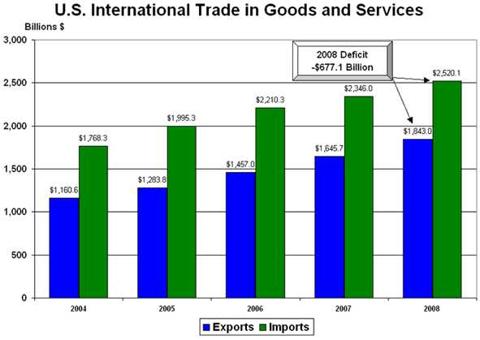
Source: US Census Bureau
Uncompetitive Labor Costs
By devaluing the currency and producing never ending inflation
while manipulating the CPI statistics to understate true inflation,
the government and Federal Reserve attempt to keep America competitive
through gimmicks rather than hard work and sacrifice. When the country
produced products that the world wanted, median family income rose
at an annual rate of 3.7% above inflation. Since 1970, using government
manipulated inflation statistics median family income has been stagnant.
If a true inflation factor was applied, the median family has lower
income today than they had 30 years ago. The only way people have
“achieved” a better life is through the use of debt, which has been
encouraged by the government, Federal Reserve and banks. This encouragement
led to the collapse of the great American Ponzi scheme in 2008.
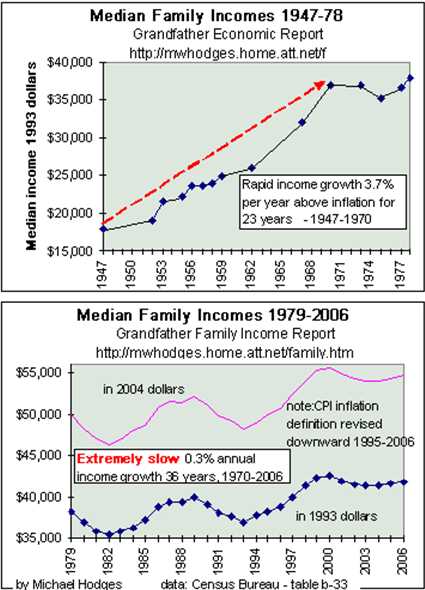
American families will see their real household incomes plunge
in the coming years to 1970 levels. The backlash against immigrants,
both legal and illegal is likely to intensify over the next few
years. The decades of allowing our economy to be hollowed out and
shipped to China is coming home to roost. Besides weapons and movies,
what does America produce that anyone wants? Our financial geniuses
have essentially brought down the worldwide financial system by
selling foreign countries MBSs, CDOs, etc. That has been our contribution
to the world in the last eight years. Now, we have delegated the
responsibility of our corporations to the U.S. government bureaucracy.
Lee Iacocca explained years ago how well the government runs things.
One of the things the government can't do is run anything.
The only things our government runs are the post office and the
railroads, and both of them are bankrupt.
Let’s See How Far We’ve Come
The lyrics to the Matchbox 20 song "Let’s See How Far We’ve
Come," describe the country’s $56 trillion unfunded liability
dilemma.
I believe the world is burning to the ground
Oh well I guess we're gonna find out
Let's see how far we've come
Let's see how far we've come
Well I, believe, it all, is coming to an end
Oh well, I guess, we're gonna pretend,
Let's see how far we've come
Let's see how far we've come
Rather than address the structural problems of our healthcare and
social security systems, our government politicians push off the
issues until after the next election. They have been doing this
for 30 years. This is why David Walker has described these cowardly
politicians as displaying “laggardship” rather than leadership.
Our elected leaders flounder from crisis to crisis using stopgap
methods to plug holes in the ship of state while ignoring the huge
iceberg on the horizon. There is one thing I am sure of. The deficits
projected by the CBO over the next four years will be hundreds of
billions higher. They haven’t taken into account emergency stimulus
packages 2 & 3.
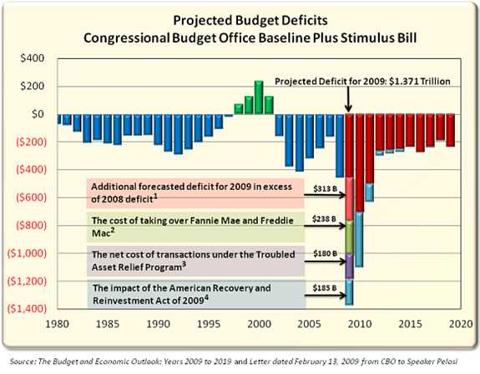
Source: PerotCharts.com
While the U.S. Titanic steams full speed ahead toward the iceberg
of unfunded Social Security, Medicare, and Medicaid liabilities,
our politicians spend our tax dollars on digging holes and then
filling them up again. As these future unfunded liabilities continue
to rise, the government’s solution is to print money, keep interest
rates at 0%, devalue the dollar, and hope for the best. The U.S.
depends on foreigners to buy more than 50% of our newly issued debt.
When you owe $10.7 trillion to others, you usually don’t get to
dictate the terms. Today, the U.S. is asking foreigners to lend
us money for 30 years at 3.5% while telling them that we will pay
them back in dollars that will be worth 30% less in the next five
years. Even a Wall Street CEO could figure out this isn’t a good
investment. The U.S. will default on this debt. It is just a matter
of when.
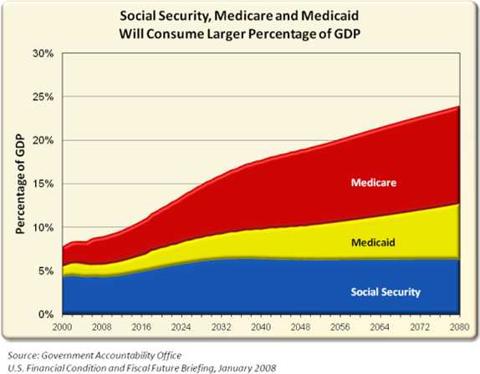
Source: PerotCharts.com
Bill Gross laid out the choices for the U.S. in 2006.
How are we to pay for this future burden of healthcare and
social security expenses? Aside from contractual legislative changes
to both areas (which are surely just around the corner), the way
a reserve currency nation gets out from under the burden of excessive
liabilities is to inflate, devalue, and tax.
The U.S. is hard at work on inflating and devaluing, while Mr.
Obama is working on the details of the taxing. The Burning Platform
for GM has already collapsed. The Burning Platform for the U.S.
is a ten alarm fire. Collapse is imminent, unless a leader with
guts and courage is willing to lead the U.S. back to fiscal sanity.
If you believe in fiscal sanity, please join me at TheBurningPlatform.com.
Bio: James Quinn is a senior director of strategic
planning for a major university. These articles reflect the personal
views of James Quinn. They do not necessarily represent the views
of his employer and are not sponsored or endorsed by his employer.
He can be reached at quinnadvisors [at] comcast . net.
Published - April 2009
|




